When selecting roosters for your flock, many people only consider the breed or the confirmation of the bird (when selecting for the Standard Of Perfection). However, a rooster can be the breed that you want or meet every checkpoint on the SOP but still be a very bad flock rooster. Here is a list of things I look for when selecting which of my roosters to keep. Some people may choose to loosen their requirements, but these are the ones I follow to get the roosters that are satisfactory.
Note: I will be using some variant of the term "removed from the flock" when speaking about what I do with roosters that do not meet my standards. What this constitutes can mean different things to different people. For me, it means culling the bird to eat. For others, who don't want to eat a bird they’ve cared for, it may mean re-homing, selling, or giving the bird his own individual housing. I can't tell you what removing a rooster from your flock will look like for you, but it is important for the safety of any people that interact with your flock, your hens, your chicks, and your other cockerels/roosters that you find a way to deal with any bad roosters that may come into your possession.
Is he tolerant of people, adults, and kids?
This is the MOST important issue for me. The reason is that I mostly have large fowl birds of very large breeds (mostly Cornish) and a 10-15 lb rooster flying at an adult can be dangerous. It is even more dangerous for children because their faces are lower and can be easily spurred. I have young children. I want my children to be involved in chicken keeping and not to have to worry about being attacked while they are working with us or out spending time with the flock.
Ideally, for me, the best roosters are wary of people without being aggressive. For example, one of my former flock roosters, Molasses, would stand back and watch any people near his flock. He actually kept a closer eye on my toddler than he did adults. However, he never offered any aggression to people, even when he was handled. He would flap and squawk and sometimes accidentally scratch while trying to get away while being handled, but he never bit, pecked, or flogged us when being handled. When his hens were being handled (which meant a lot of squawking), he would often run up to investigate but would back off when he saw a person was the cause of the disruption.
I would still have him as the main flock rooster, however, I didn't want to breed Cochins anymore and I sold him to a lovely lady that was buying his hens.

For me, any of the following actions towards people, get a rooster removed from my flock:
Note: I know not everyone will agree with or want to be this stringent about their rooster's behavior where people are concerned. I do believe rehabilitation is possible for more minor offenders. However, with my family's make-up, I can't risk keeping any rooster that displays any of the behaviors above. For folks who want to try retraining their roosters, Beekissed's Rooster Speak is the best resource I've seen on the topic. I've used some of the techniques mentioned in the original post with my own roosters to good effect, but I realized I can't depend on a child to project the same confidence and dominance in order to be safe. I intend to teach my kids how to use the tools mentioned in the article, but I will be aiding their learning by only keeping roosters that meet my more stringent criteria.
Is he nice to and protective of his hens?
Ideally, a rooster should be attentive, protective, and respectful to his hens and not be overly aggressive while mating. Some problems with mating can happen when you don't have enough hens for your rooster. Most people say you need at least 10 hens per rooster. I find that numbers can often be too low. I prefer at least 15-20 hens per rooster in a flock situation. When it comes to breeding pens, the ratios are often lower, 2-4 hens per rooster, so that you are breeding with your best stock. In a breeding situation, the rooster can always be removed and added back 2 times a week to achieve fertility. However, in a flock situation that is more difficult, especially if the rooster has more than enough hens to meet his needs. Some wear on feathers around the head and saddle area is to be expected, but excessive wear can be a sign of over-breeding or overly aggressive breeding.


To determine if the cause is over-breeding or aggressive breeding, you need to watch your flock.
If you have the proper flock ratios, you can remedy over-breeding by giving the affected girls hen saddles to protect their backs, trimming your rooster's spurs, or housing your rooster(s) separately from your hens part of the time.
In an aggressive breeding scenario, it will be obvious that the rooster is actively hurting a hen when he is mating her. Often, hens will not squat for a rooster that is aggressive with them, so he will use force. This can also be seen in younger roosters who are learning the proper way of things, but sometimes with mature girls should whip him into shape and teach him some manners. A truly aggressive breeder, will not relent or learn as he gets older (9 months for fast-maturing breeds, 12 for slower maturing breeds, or a month after being added to a flock if they are older). If you've remedied the ratios, tried using older girls to school him, and protected your girls with saddles and spur trimmings and he is still managing to hurt some of your hens, he should be removed from your flock.
Another factor you want to look at is, how does he treat your hens when food is involved. A good, caring rooster will make this soft clucking noise when they find anything that may be appetizing to call his hens to eat and he will drop bits of the food in front of them. This behavior is called "tidbitting". He will also allow them to eat first. Some good roosters will eat as well, but they will alternate between watching for threats, eating, and tidbitting. A not-so-good rooster will try to bolt down as much food as he can while it is there without calling his hens to the feast. A BAD rooster will actively interfere with the hens while they are eating to try to get more food for themselves. This is what the first rooster did. General Tso was a beautiful Dominique/RIR rooster. However, when it came to the food he was vicious. If the hens got to the feed first he would run up, jump on top of the hen closest to him, and actively shove her away from the food bowl. Once the food was gone from that section of the bowl, he would then start bullying the other hens away from the rest of the food. This is not the behavior you want to see in your flock rooster and was one of the many reasons General Tso was removed from my flock.

Another thing you need to watch for is a rooster that is an outright bully to your hens. If you have any rooster that beats up on hens for ANY reason, he needs to be removed from your flock. I'm not talking about little sparring matches with dominant hens to decide the flock hierarchy. These rarely get out of hand and usually only end up with minor injuries to the comb or wattles, if any injury is apparent. I'm talking about knock-down, drag-out fights that leave your hen bleeding and running away and the rooster pursues after the hen gives up. That is NOT okay and should not be tolerated.
Is he nice to and protective of chicks?
When selecting a flock rooster, I prefer to have a rooster that will care for chicks almost as much as a broody hen will. This includes tidbitting for the chicks, shepherding them around, gently schooling them when they get out of line, and protecting them from predators and overly aggressive hens. Molasses, my Black Cochin, was one such rooster. He loved little chicks and was always very good with younger birds. When he was 4-5 months old Molasses was bullied so badly by the head flock rooster I had at the time, that he nearly starved to death. So we decided to move him in with my flock of Delaware and New Hampshire chicks. When we added him to their pen, the New Hampshire cockerel chick with the biggest comb immediately challenged him to a battle. When the chick attacked him, Molasses gave him one swift kick and a peck on the head. The chick ran away, squawking in distress and Molasses let him be. He was really good with these chicks and could be seen sheltering them under his wings or letting them snuggle up to him. Later, when I let my second broody raise her chicks with the flock, he was almost a secondary mom to the babies. He even protected them from the sassiest Delaware and New Hampshire hens that grew up with him.


At the very least, a flock rooster should leave any chicks alone.
Excessively pecking, harassing, throwing, or mauling chicks is not acceptable behavior and is cause for removing him from the flock.
Is he tolerant of other roosters?
The reason I use the term "tolerant" of other roosters is that even the best flock rooster doesn't necessarily like sharing his ladies with another man. While you may occasionally have a situation where you get "best buddy" roosters in your flock, you shouldn't necessarily expect this to be the norm. When you want to introduce a new rooster into a flock, you can do it one of two ways. The easiest transition is to introduce the new "rooster" when he is still a young cockerel that hasn't reached sexual maturity yet (14 weeks or less) and allow the alpha rooster and the cockerel to slowly figure out the hierarchy as the cockerel matures. The other way, with a sexually mature cockerel/rooster, is to do a "see, no touch" introduction for a week or two and then let him in with the flock while you are there to supervise. In either case, there may be some "cockfighting" to try to determine the pecking order. This is completely normal and should be expected. What should happen, after no more than 10 min of fighting, one rooster/cockerel should give in and retreat. A little bit of chasing by the winning rooster/cockerel should be expected. However, what is NOT acceptable is for the winner to chase down the loser and continue to flog him. Another thing that is not acceptable, is for the winner to flog the loser every time he sees him. This is what happened to Molasses before I moved him into the pen with the chicks. I added him and the Buff Orpington chicks he was raised within with my main flock. Alfredo, my flock rooster at the time, a leghorn mutt, did not like any of the cockerels. He made it his mission to hunt them down any time he saw them. There were 16 Buff cockerels and Molasses. The Buff cockerels were faster than Alfredo and, with so many of them, it was hard for Alfredo to corner any single one of them. Molasses, being a LF Cochin, was slower and easier to pick out of the crowd. Every time Alfredo saw Molasses, he would chase him down and flog him until Molasses retreated into the coop. He also didn't allow Molasses to come out and eat at feeding time.

If you are only going to keep one rooster, this may not be much of a problem. Alfredo fit all my other criteria, except that he wasn’t a purebred of a breed I wanted to continue breeding, and if I was only going to keep a few hens and rooster for protection, this wouldn't have been an issue. However, at a later point, he pinned down another rooster and almost flogged him to death. This led me to remove him from my flock because I need to keep multiple roosters to achieve my goals.
Updated note: I've changed my thinking on this a little bit since I initially wrote this article. I'm currently working with Heritage Cornish meat birds. The birds are fine when they grow up and stay together but when I separate them for breeding purposes I can't put them back together without them injuring each other (joint injuries from trying to fight and falling to the ground). Their body confirmation doesn't allow them to be as resilient as other breeds after having a minor cockfight. Even the hens have a tendency to fight when groups are mixed back together if they aren't kept in view of the other hens. I am mainly concerned with non-aggression towards humans over the rooster aggression issue. I will probably be keeping the breeding roosters separate from other roosters in the future.
In conclusion
There is always a way to find a good rooster, and there is never a reason to put up with a bad flock rooster. Even if he is the best-looking specimen of the breed you've ever seen, you do not want to breed him and risk his offspring having the same temperament or worse. I find that offspring from even-tempered hens and roosters generally have a similar disposition as their parents. You don't want to breed any aggression forward.
Don't ever think you have to put up with a bad flock rooster.
Note: I will be using some variant of the term "removed from the flock" when speaking about what I do with roosters that do not meet my standards. What this constitutes can mean different things to different people. For me, it means culling the bird to eat. For others, who don't want to eat a bird they’ve cared for, it may mean re-homing, selling, or giving the bird his own individual housing. I can't tell you what removing a rooster from your flock will look like for you, but it is important for the safety of any people that interact with your flock, your hens, your chicks, and your other cockerels/roosters that you find a way to deal with any bad roosters that may come into your possession.
Is he tolerant of people, adults, and kids?
This is the MOST important issue for me. The reason is that I mostly have large fowl birds of very large breeds (mostly Cornish) and a 10-15 lb rooster flying at an adult can be dangerous. It is even more dangerous for children because their faces are lower and can be easily spurred. I have young children. I want my children to be involved in chicken keeping and not to have to worry about being attacked while they are working with us or out spending time with the flock.
Ideally, for me, the best roosters are wary of people without being aggressive. For example, one of my former flock roosters, Molasses, would stand back and watch any people near his flock. He actually kept a closer eye on my toddler than he did adults. However, he never offered any aggression to people, even when he was handled. He would flap and squawk and sometimes accidentally scratch while trying to get away while being handled, but he never bit, pecked, or flogged us when being handled. When his hens were being handled (which meant a lot of squawking), he would often run up to investigate but would back off when he saw a person was the cause of the disruption.
I would still have him as the main flock rooster, however, I didn't want to breed Cochins anymore and I sold him to a lovely lady that was buying his hens.
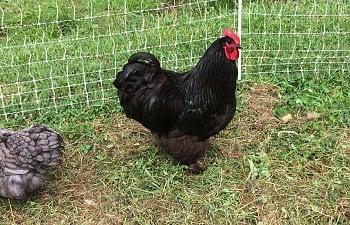
For me, any of the following actions towards people, get a rooster removed from my flock:
- Pecking a person
- Flogging a person
- Chasing a person
- Offering to fight a person like they are another rooster
- Displays of dominance over a person
Note: I know not everyone will agree with or want to be this stringent about their rooster's behavior where people are concerned. I do believe rehabilitation is possible for more minor offenders. However, with my family's make-up, I can't risk keeping any rooster that displays any of the behaviors above. For folks who want to try retraining their roosters, Beekissed's Rooster Speak is the best resource I've seen on the topic. I've used some of the techniques mentioned in the original post with my own roosters to good effect, but I realized I can't depend on a child to project the same confidence and dominance in order to be safe. I intend to teach my kids how to use the tools mentioned in the article, but I will be aiding their learning by only keeping roosters that meet my more stringent criteria.
Is he nice to and protective of his hens?
Ideally, a rooster should be attentive, protective, and respectful to his hens and not be overly aggressive while mating. Some problems with mating can happen when you don't have enough hens for your rooster. Most people say you need at least 10 hens per rooster. I find that numbers can often be too low. I prefer at least 15-20 hens per rooster in a flock situation. When it comes to breeding pens, the ratios are often lower, 2-4 hens per rooster, so that you are breeding with your best stock. In a breeding situation, the rooster can always be removed and added back 2 times a week to achieve fertility. However, in a flock situation that is more difficult, especially if the rooster has more than enough hens to meet his needs. Some wear on feathers around the head and saddle area is to be expected, but excessive wear can be a sign of over-breeding or overly aggressive breeding.
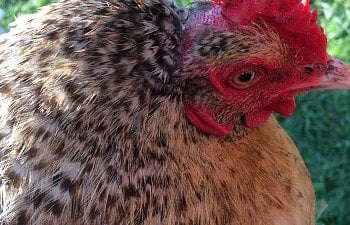
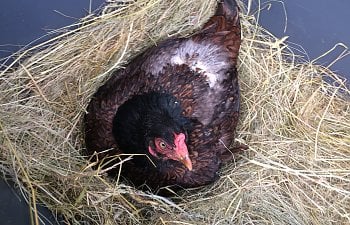
To determine if the cause is over-breeding or aggressive breeding, you need to watch your flock.
If you have the proper flock ratios, you can remedy over-breeding by giving the affected girls hen saddles to protect their backs, trimming your rooster's spurs, or housing your rooster(s) separately from your hens part of the time.
In an aggressive breeding scenario, it will be obvious that the rooster is actively hurting a hen when he is mating her. Often, hens will not squat for a rooster that is aggressive with them, so he will use force. This can also be seen in younger roosters who are learning the proper way of things, but sometimes with mature girls should whip him into shape and teach him some manners. A truly aggressive breeder, will not relent or learn as he gets older (9 months for fast-maturing breeds, 12 for slower maturing breeds, or a month after being added to a flock if they are older). If you've remedied the ratios, tried using older girls to school him, and protected your girls with saddles and spur trimmings and he is still managing to hurt some of your hens, he should be removed from your flock.
Another factor you want to look at is, how does he treat your hens when food is involved. A good, caring rooster will make this soft clucking noise when they find anything that may be appetizing to call his hens to eat and he will drop bits of the food in front of them. This behavior is called "tidbitting". He will also allow them to eat first. Some good roosters will eat as well, but they will alternate between watching for threats, eating, and tidbitting. A not-so-good rooster will try to bolt down as much food as he can while it is there without calling his hens to the feast. A BAD rooster will actively interfere with the hens while they are eating to try to get more food for themselves. This is what the first rooster did. General Tso was a beautiful Dominique/RIR rooster. However, when it came to the food he was vicious. If the hens got to the feed first he would run up, jump on top of the hen closest to him, and actively shove her away from the food bowl. Once the food was gone from that section of the bowl, he would then start bullying the other hens away from the rest of the food. This is not the behavior you want to see in your flock rooster and was one of the many reasons General Tso was removed from my flock.
Another thing you need to watch for is a rooster that is an outright bully to your hens. If you have any rooster that beats up on hens for ANY reason, he needs to be removed from your flock. I'm not talking about little sparring matches with dominant hens to decide the flock hierarchy. These rarely get out of hand and usually only end up with minor injuries to the comb or wattles, if any injury is apparent. I'm talking about knock-down, drag-out fights that leave your hen bleeding and running away and the rooster pursues after the hen gives up. That is NOT okay and should not be tolerated.
Is he nice to and protective of chicks?
When selecting a flock rooster, I prefer to have a rooster that will care for chicks almost as much as a broody hen will. This includes tidbitting for the chicks, shepherding them around, gently schooling them when they get out of line, and protecting them from predators and overly aggressive hens. Molasses, my Black Cochin, was one such rooster. He loved little chicks and was always very good with younger birds. When he was 4-5 months old Molasses was bullied so badly by the head flock rooster I had at the time, that he nearly starved to death. So we decided to move him in with my flock of Delaware and New Hampshire chicks. When we added him to their pen, the New Hampshire cockerel chick with the biggest comb immediately challenged him to a battle. When the chick attacked him, Molasses gave him one swift kick and a peck on the head. The chick ran away, squawking in distress and Molasses let him be. He was really good with these chicks and could be seen sheltering them under his wings or letting them snuggle up to him. Later, when I let my second broody raise her chicks with the flock, he was almost a secondary mom to the babies. He even protected them from the sassiest Delaware and New Hampshire hens that grew up with him.
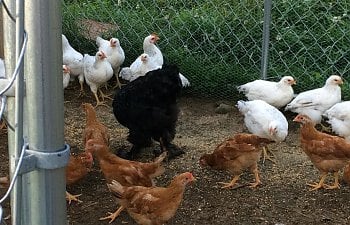
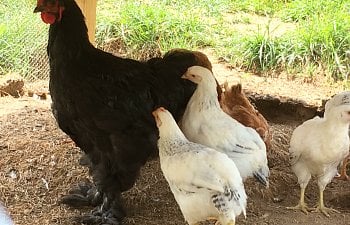
At the very least, a flock rooster should leave any chicks alone.
Excessively pecking, harassing, throwing, or mauling chicks is not acceptable behavior and is cause for removing him from the flock.
Is he tolerant of other roosters?
The reason I use the term "tolerant" of other roosters is that even the best flock rooster doesn't necessarily like sharing his ladies with another man. While you may occasionally have a situation where you get "best buddy" roosters in your flock, you shouldn't necessarily expect this to be the norm. When you want to introduce a new rooster into a flock, you can do it one of two ways. The easiest transition is to introduce the new "rooster" when he is still a young cockerel that hasn't reached sexual maturity yet (14 weeks or less) and allow the alpha rooster and the cockerel to slowly figure out the hierarchy as the cockerel matures. The other way, with a sexually mature cockerel/rooster, is to do a "see, no touch" introduction for a week or two and then let him in with the flock while you are there to supervise. In either case, there may be some "cockfighting" to try to determine the pecking order. This is completely normal and should be expected. What should happen, after no more than 10 min of fighting, one rooster/cockerel should give in and retreat. A little bit of chasing by the winning rooster/cockerel should be expected. However, what is NOT acceptable is for the winner to chase down the loser and continue to flog him. Another thing that is not acceptable, is for the winner to flog the loser every time he sees him. This is what happened to Molasses before I moved him into the pen with the chicks. I added him and the Buff Orpington chicks he was raised within with my main flock. Alfredo, my flock rooster at the time, a leghorn mutt, did not like any of the cockerels. He made it his mission to hunt them down any time he saw them. There were 16 Buff cockerels and Molasses. The Buff cockerels were faster than Alfredo and, with so many of them, it was hard for Alfredo to corner any single one of them. Molasses, being a LF Cochin, was slower and easier to pick out of the crowd. Every time Alfredo saw Molasses, he would chase him down and flog him until Molasses retreated into the coop. He also didn't allow Molasses to come out and eat at feeding time.
If you are only going to keep one rooster, this may not be much of a problem. Alfredo fit all my other criteria, except that he wasn’t a purebred of a breed I wanted to continue breeding, and if I was only going to keep a few hens and rooster for protection, this wouldn't have been an issue. However, at a later point, he pinned down another rooster and almost flogged him to death. This led me to remove him from my flock because I need to keep multiple roosters to achieve my goals.
Updated note: I've changed my thinking on this a little bit since I initially wrote this article. I'm currently working with Heritage Cornish meat birds. The birds are fine when they grow up and stay together but when I separate them for breeding purposes I can't put them back together without them injuring each other (joint injuries from trying to fight and falling to the ground). Their body confirmation doesn't allow them to be as resilient as other breeds after having a minor cockfight. Even the hens have a tendency to fight when groups are mixed back together if they aren't kept in view of the other hens. I am mainly concerned with non-aggression towards humans over the rooster aggression issue. I will probably be keeping the breeding roosters separate from other roosters in the future.
In conclusion
There is always a way to find a good rooster, and there is never a reason to put up with a bad flock rooster. Even if he is the best-looking specimen of the breed you've ever seen, you do not want to breed him and risk his offspring having the same temperament or worse. I find that offspring from even-tempered hens and roosters generally have a similar disposition as their parents. You don't want to breed any aggression forward.
Don't ever think you have to put up with a bad flock rooster.


